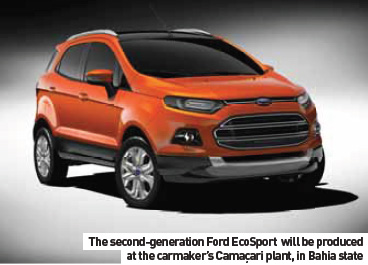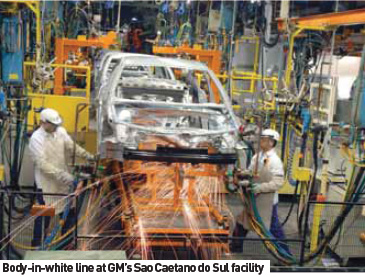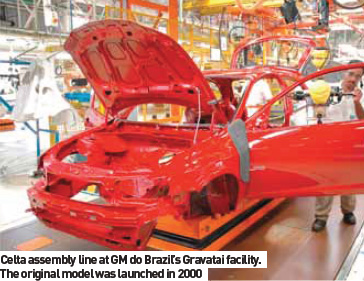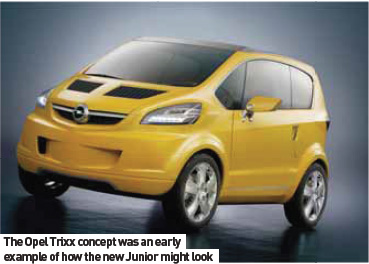Various factors allowed the Brazilian economy to maintain a steady course of growth through the otherwise global economic downturn of 2008 and 2009. For its part, the national government of former president Luiz Inácio Lula da Silva was injecting large amounts of cash collected from an increasing tax base into a series of new social programmes that served to push more of the country’s population into the growing middle class. At the same time, a reduction in interest rates and related financing costs further served to create a boom in consumer spending.
It was during this period that local OEMs were reaping profits linked to the introduction of models featuring engines which could use both petrol and locally-produced ethanol fuel in any given percentage mix. This prompted a wave of vehicle purchasing unlike any that had been seen in the country, to the point that over 80% of all vehicle sales in 2009 were of models with such “flex-fuel” powertrains.
Since those halcyon days, the Brazilian economy has become a victim of its own success. An over-heating economy has forced the national government, now led by president Dilma Rousseff, to increase interest rates in an attempt to control rising inflation. While this is currently running at an annual rate of +/- 6%, it is still far below the astronomical inflation rates recorded over past decades. Even so, the rate increases have been passed through to the marketplace, which has served to cool the local automotive market. Having put in place programmes of expansion to deliver an increasing number of vehicles during recent periods of high demand, this has in turn led to market oversupply. Many dealers are reporting inventories far in excess of the optimum 30 days, which has prompted companies like Ford to temporarily halt production at some of its Brazilian plants – a significant event in itself considering the recent strength of the automotive sector.
 Model behaviour
Model behaviour
In a market where it remains illegal to fit diesel engines to passenger vehicles, Brazilians were originally tempted to purchase new flexible-fuel models to take advantage of the lower price-per-litre of the ethanol-based fuel. Now that demand for vehicles with flex-fuel powertrains has peaked, carmakers are planning to launch a range of new models in order to maintain the market momentum they enjoyed over the past decade.
A case in point is Ford’s plan to start production of a new, second-generation EcoSport. This new model, which will be sold in various emerging markets around the world, will be produced at the carmaker’s Camaçari plant, in Bahia state, for Brazilian buyers and other South American markets. Smaller than the Focus-platformed Kuga, the EcoSport is based on a modified Fiesta platform; it should come as no surprise that the same plant also produces the Fiesta hatch and saloon models.
Starting operations in 2001, Camaçari remains one of Ford’s most advanced production facilities, featuring a depth of automation beyond that of any of the carmaker’s North American plants. Further to this, inventory has been reduced to a bare minimum or completely eliminated by having suppliers making and delivering subassemblies and other components, either in facilities adjacent to the plant or next to the line, which has taken the concept of just-in-time to a new level of efficiency.
Freeing up trade
What could help Ford and other carmakers with production facilities in Brazil is the recently agreed update to the free trade agreement which affects vehicle imports between Mexico and the South American country. Due to the increasing value of the Brazilian real, the country has increasingly been viewed as a favourable area to sell exported vehicles. To this end, year-on-year vehicle imports from Mexico in 2011 increased almost 70%.

In order to make local carmakers more competitive, the two countries have agreed that Mexico will export vehicles of a value totalling no more than $1.45 billion, increasing to $1.64bn in 2014 – there were previously no limits on total imported vehicle value limits. Carmakers in Mexico will further be required to increase the percentage of Latin American parts used in vehicle production from the current 30% to 35% by the end of 2012, which will be followed by a further increase to 40% by 2016. The sum effect of this restriction will serve to increase the retail cost of vehicles imported from Mexico, such as the Ford Fusion saloon, which might convince local buyers to purchase an equivalent, locally manufactured product.
The need for such an agreement is indicative of the rising cost of manufacturing cars in Brazil. Around the world, and Brazil is no exception, carmakers are uniformly bearing the cost of increasing raw material prices and to pass on such increases to the customer would make their respective vehicles uncompetitive in the marketplace. Further to this is the increasing cost of labour. While Rouseff is planning to cut back on some of the social programmes put in place by her government’s predecessor, she is planning to increase the national minimum wage of R$545 per month by 14% over this year – which will also be applied to the standard thirteenth salary, which is paid as a Christmas bonus to all workers. Wages across all sectors are likely to increase as a result, meaning a proportional drop in margins on each vehicle sold.
As costs increase, Brazilian carmakers are gradually taking control of their own destiny in terms of vehicle development. A case in point is the replacement of the Chevrolet Vectra (known as the Astra (C) in most other global markets) with an all-new Cobalt model. Linked to the Cobalt produced at GM’s Lordstown, Ohio plant in name only, the largely Brazilian-developed Cobalt joins a range of new model launches including the premium Cruze saloon and a soonto- be-introduced hatchback. José Eugênio Pinheiro, vicepresident of manufacturing at GM do Brasil, explains more about how the carmaker brought the Cobalt to market.

“Our engineers in Brazil designed the Cobalt, but it is on a global platform, a global architecture. So the car is new, but ituses a pre-existing platform.” To achieve the required level of manufacturability, Pinheiro says that product and manufacturing teams worked together from the start of the project. “These interactions meant that whenever an engineer was testing a prototype, we had our team working with them to analyse the manufacturability and ease of assembly of the part or component – it is how we have always done it. When the vehicle came into production, we expected that there would be minor things to be adjusted. Poor development from a supplier, a process not delivering consistent quality or some other minor tweaks had to be resolved with the engineers, but after that was done we didn’t have any major issues.”
Pinheiro goes on to describe how the car was integrated into production at the GM facility in Sao Caetano do Sul, which at the time was already producing the Cruze saloon. “When we launched the Cruze the line was empty, we could do anything without causing any interference. We had all the time to do whatever we wanted; it was easy to supply, easy to check. Then came Cobalt and I couldn’t just stop the line to incorporate the new model, we had to maintain Cruze production. So the question was when is the best time to stop the line and do the work, how do we fine tune the production processes?”
AMS caught up with Silvio Illi, general manager of Ford’s Sao Bernardo do Campo plant, to ask what he thought were the main challenges in the future for carmakers in Brazil.
AMS: What are the challenges to be overcome in order for Brazil-based OEMs to maintain success in the domestic and export markets?
Silvio Illi: I am concerned that Brazilian industry is rapidly losing [its] competitiveness. This is due to several factors but the main ones are the strong currency and the country’s high structural cost – the high cost and difficulty of procuring the right parts at the right price – and of course, logistics difficulties.
AMS: Will competition for Ford’s market share come from within South America or from further afield?
SI: At present, imported products from Mexico, Korea and China are winning market share. Also, I think we will see a lot more of them as Chinese OEMs, in particular, build plants here.
AMS: So, what should carmakers be concentrating on for the next year?
SI: I would suggest that we all try to fi nd the right model for driving Brazil to a new level of competitiveness, taking lessons from [vehicle makers] all around the world and from other global industries. For example, what are all the industries in countries like Korea and Mexico doing differently from us?
Sheet metal solutions
As the Sao Caetano plant was operating over three shifts, with day shifts operating over five days and night shifts operating over six days, the best time to complete the production integration was over the weekend, but this was not the end of the problems related to adding Cobalt assembly. “The Sao Caetano plant already features a flexible production line, but we underestimated the time needed to integrate the new model. There were other issues, too. For example, the thickness of the sheet metal caused a few problems. [The Cobalt] is a low-weight car and to achieve this target we had to reduce the thickness of the sheet metal. In the plant, we had to change the way the parts are handled to minimise the potential for any damage related to the different sheet metal thickness.”
Another problem related to the thickness of the sheet material was how the heat of the curing process in the paintshop ovens affected outer panels. To solve this issue, engineers at the plant needed to determine a mean temperature that would cure the painted Cobalt bodies without affecting the thinner outer skins, while also being sufficient to cure the painted Cruze bodies. Although Pinheiro doesn’t mention the temperature at which the ovens now operate, he says there is no need for any model batching as the ovens now operate at a heat level that works for both models.
GM do Brasil has been producing and selling vehicles in Brazil under the Chevrolet brand for the last 87 years. In 2011, Chevrolet sold 632,219 vehicles in the country. The company has three main vehicle assembly plants, located in São Caetano do Sul, São José dos Campos, both in Sao Paulo, and Gravatai. It also has sites in Mogi das Cruzes (stamping plant), Sorocaba (Chevrolet Logistic Center) and Indaiatuba (Proving Ground), all in Sao Paolo. Besides these the company has a modern Technologic Center of Engineering and Design at Sao Caetano do Sul, SP with complete capacity to develop new vehicles. The Brazilian subsidiary is one of fi ve centers worldwide in the creation and development of vehicles in engineering, design and manufacturing areas.

The global experience
The question remains, why spend money developing the Cobalt when it is in the same segment as the Cruze in terms of overall size? Pinheiro explains: “The Cobalt and Cruze are a similar size, but they are in different segments in terms of material cost. They appeal to totally different customers. The Cruze is a premium product, while Cobalt pricing starts at about 60% of the Cruze. This means the Cobalt starts at about R$40,000 and Cruze at about R$60,000, so the difference is related to price. With the Cobalt, we wanted a large car that offers a lot of space, a car that is comfortable but affordable. This is what the market wants and it was well received, it is selling very well. The car was initially developed for Brazil, but there are other countries now looking to produce the same car.”
Building the Cobalt in various global regions sounds like a good plan. Combining a large amount of interior space and overall value–essentially, it’s a lot of car for your money– the model would appeal to customers in regions such as India and south-east Asia. Pinheiro further points out that plants producing the model could benefit from the supplier arrangements that have already been put in place by GM do Brasil.
“Being global products, some of the components are used globally. Part of this relates to the global architecture, including the floorpan, the front end, most of the underbody. This means that some of the components have been developed globally, so we have parts coming from India, China, South Korea. We didn’t have this before with our [Vectra and Corsa] legacy products, these were all internal. Now we have to readjust because it’s a different pipeline. If there was a [supply] problem in Brazil we just had to say ‘stop sending parts’ and we’d fix the problem. This didn’t affect the pipeline too much; it was only a couple of hours long. Global supply means that you send the same message to the supplier and it affects two months of product already in the pipeline.”

Pinheiro adds that there are other unpredictable parameters which can affect the business model of a global vehicle. For example, if there is a sudden upswing in the demand for high-specification cars, it is possible that the parts already in the extended supply pipeline have not taken this market change into account, meaning longer customer delivery times for these models. With this in mind, he says building a global model has been a learning process for all those involved with the project. “It doesn’t mean that I’m going to change the mix, but we have to apply different rules in order to make sure we get the parts we need. Cobalt production has been an education for us in that is was the first product that brought these difficulties to our attention.”
Local challenges
GM do Brasil is currently in the middle of an unprecedented series of model launches, which in addition to the Cobalt includes the S-10 pickup (known as Colorado in markets outside Brazil). A third model is scheduled to enter production at the Sao Caetano facility by the end of this year, while another “three or four” models will be added to the GM line up in Brazil over 2013.
“We are not standing still,” says José Eugênio Pinheiro. “I cannot reveal a lot of details, but we have a lot of new models due for launch into the market. We had reasons – the global problems – but I think we delayed our portfolio changes for too long. This is why we have such a concentrated series of model launches over such a short period of time. Plus, it creates a nice wave of momentum.” General Motors is not the only company with ambitious plans related to new model launches. Established in-country OEMs including Fiat and Volkswagen are also planning to introduce new models. A further challenge to carmakers already operating in Brazil comes the shape of carmakers building vehicles in-country for the first time, such as South Korea’s Hyundai and Chinese companies Chery and Jianghuai Automobile (JAC). Pinheiro says that the addition of these new manufacturers has forced GM to look outside its existing supplier network in order to secure part deliveries for its own new cars.
“There are more people building cars in Brazil than ever before. For example, Hyundai brought a lot of its own suppliers here to support the new plant, but they will need to have some local suppliers. Everybody in Brazil is either building a new plant or expanding existing plants and now the Chinese are coming and they’re also taking [supplier] capacity. Component suppliers see this as an opportunity, so they try to get a larger piece of the pie.”
GM expansion
The GM models which stands to lose the most market share to the Chinese newcomers are the related Chevrolet Celta hatchback and Prisma saloon. Based on the previous generation Corsa platform, these South America-only models are positioned below the current Corsa in the model line-up. Built at the GM plant in Gravataí, Rio Grande do Sul, Pinheiro says that one of the new models he is planning for 2013 will be a new addition to the Celta range. It can only help, as while the original Celta was the fastest-selling model at launch in company history, it has remained largely unchanged since the three-door hatchback was introduced in 2000 (the five-door version was introduced in 2002).
The addition of the third Celta-based product has prompted a series of improvements to be carried out at the Gravataí plant, which only manufactures the Celta and its derivatives. “We had a fully automated marriage station installed, but it was a 12-year old system and it caused us some headaches. You have to consider that software that old doesn’t work anymore; it’s even difficult to find someone to work on that software package! So we decided to redo this area and we designed a more modern process, the tooling and the equipment, hardware and software, all with the goal of achieving easier updates and maintenance.”
Together with the new marriage station and improved automation in areas such as the bodyshop, Pinheiro says he has managed to increase output at Gravataí from 53 to 63 jobs per hour. “[The Chinese cars] will put pressure on the Celta and Prisma, but we think that the new model will remove some of that pressure. Both these cars are still doing very well in the market.”
In terms of overall production capacity, Pinheiro says that he is not looking to add any further assembly plants. He states that such physical expansion is unnecessary when he can still drive through efficiency improvements like those put in place at Gravataí, while still having the option to add shifts at plants including the GM facility at São José dos Campos.
Something for the future?
With almost 13 years having passed since the launch of the original three-door Celta, the model would appear ready for replacement. Scheduled for introduction in 2013, the new Junior would appear an ideal candidate, but according to General Motors executives speaking at this year’s Geneva Motor Show, the new city car will be only be produced in Europe for the foreseeable future. Although GM do Brasil is rapidly gaining experience in the development and launch of new models, would it not make good business sense to position the Junior as a replacement for the original Celta, neatly avoiding related development and launch costs? If Junior does not come to Brazil, Pinheiro says he would be happy to see the city car’s new three-cylinder engine made available in the local market. But for now his engine concerns currently surround start of production at a new greenfield engine production facility in Joinville. “This plant will produce a four-cylinder engine, the same as the current engine we have today, but it is a bridge for the next engine. We have also announced that this facility will produce a new six-speed transmission.” He further explains that while local production will use a large portion of these gearboxes, the remainder will be exported to markets outside South America.
Moving forward
The move to limit finished vehicle imports from Mexico looks like a case of low-level protectionism, but in spite of the national government deciding to help local vehicle manufacturers maintain market share, José Eugênio Pinheiro says that the small yet appreciable market downturn has still to set any alarm bells ringing. “We still see the market growing. We are projecting 3.5 to 4.5% growth over the next few years. I don’t think that anyone is projecting 10 or 12% like China experienced over the past few years, but up to 4.5% growth is a good assumption.”
He further points out that producing cars in Sao Caetano, which is very close to central Sao Paulo, will mean further difficulties when trying to compete with South Korean and Chinese carmakers. “Where we are located, this is our Detroit. It has created a very strong labour market. This is why Chery, JAC, Hyundai, are building plants in other areas, to achieve lower labour costs.”
For now, Pinheiro says he can beat the newcomers by offering better quality, but he says that the Chinese especially will improve in this area. “The companies that have been here for decades had better keep a close eye on these new car makers. What I plan to do to remain competitive is build a better car and this means being competitive on the product side and on the manufacturing side.”



































